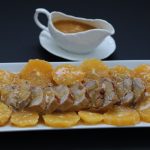Dutch Oven Pork Tenderloin With Oranges (AIP, Paleo, Whole30)
Stove top pork tenderloin cooked in a Dutch oven with oranges and orange juice.
Servings: 4 servings
Calories: 685kcal
Equipment
Ingredients
- 1 pork tenderloin (the one I'm using here weighs 500 g (1.1 pounds))
- 1 Tablespoon extra virgin olive oil
- 500 milliliters freshly squeezed orange juice (quantity will vary according to the size of your pork tenderloin and of the Dutch oven you're using please see notes for more explanations)
- 1 Tablespoon arrowroot (see notes below for substitutions)
- 3 oranges fresh
- Pinch of sea salt
Instructions
- Put a Dutch oven on medium high heat and pour the olive oil in it.
- When the olive oil is hot, put the pork tenderloin in the Dutch oven and cook it for about 2 minutes on both sides until it gets a golden color.
- Pour the orange juice in the Dutch oven. As explained above, the quantity of orange juice will vary according to the size of your pork tenderloin and the size of your Dutch oven.
- Then let it cook on medium high heat (the orange juice should be on the verge of boiling but not boil completely) for about 20-25 minutes. At half the time, flip the pork tenderloin on the other side.
- In the meantime, using a knife, peel the oranges making sure to also remove the white membrane. And slice them. Add the orange slices to the Dutch oven at the end of the cooking process (for about 5 minutes only).
- Once the meat is cooked remove it along with the orange slices from the Dutch oven (leave the orange juice in the Dutch oven). And set them on a plate.
- Take a seperate bowl and transfer the arrowroot in it. Using a ladle or a very large spoon take about ½ cup (125ml) of orange juice out of the Dutch oven and pour it slowly over the arrowroot while whisking. Once the arrowroot is well combined to the orange juice, transfer the bowl content to the Dutch oven and mix the 2 juices together (I find that this method avoids getting lumps rather than if you pour the arrowroot directly in the Dutch oven).
- Pour part of the orange juice over the meat and put the rest in a sauce boat. Et voilà! Serve immediately with cauliflower rice (if you are on AIP, paleo or whole30) or serve with rice (if you are not on any of those diets).Bon appétit!
Notes
Arrowroot substitutions. If you are not cassava intolerant, you can use tapioca flour instead of arrowroot. Both are AIP, paleo and whole30 compliant. If you are not on the AIP, paleo nor whole30 diets you can use potato or corn starch instead of arrowroot.
To make sure that the pork tenderloin is cooked, slice it in the middle. Then look at its color: it should NOT be pink (or only very faintly).
The orange juice quantity in this recipe will both depend on the size of your pork tenderloin and the size of your Dutch oven. You need to make sure that about half of your pork tenderloin is soaking in the orange juice. So that it will properly cook in it and get the nice orange flavor. If your Dutch oven is bigger than mine (I'm using a 2.5 qt / 2.4 L Dutch oven) you will need more orange juice. And if your pork tenderloin is smaller than mine, using the same dutch oven size, you might need a little less orange juice. Your pork tenderloin should be soaking in orange juice but not completely immersed (to the point where you can't see the meat) in it.
You might also need to adjust the quantity of arrowroot. Let's say you end up using twice as much orange juice as I do, you will also need twice as much arrowroot. The purpose of the arrowroot is to thicken the sauce.
Please keep in mind that the nutritional information is calculated using a nutrition facts calculator. It is a rough estimate and can vary greatly based on products used.
Nutrition
Serving: 200g | Calories: 685kcal | Carbohydrates: 26g | Protein: 95g | Fat: 20g | Saturated Fat: 6g | Trans Fat: 1g | Cholesterol: 295mg | Sodium: 237mg | Potassium: 2210mg | Fiber: 3g | Sugar: 20g | Vitamin A: 480IU | Vitamin C: 115mg | Calcium: 81mg | Iron: 5mg
